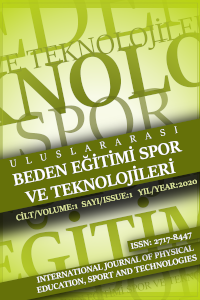Antropometrik ölçümler ile temel beceriler arasındaki ilişki
Anthropometric measurement has revealed correlation between body structure physical characteristics and motor abilities. Assessment of anthropometric parameters and motor abilities will provide more accurate information on the developmental process of children. The aim of the study was to find out the relationship between selected anthropometric measurement and fundamental skills. The study was delimited in loco-motor skills and ball skills only of fundamental movement skills. For fulfilling the purpose, the data were estimated from the Primary school students of Amravati city, Maharashtra. Forty-eight male primary school students, whose ages ranging from 7-10 year-old were taken by simple random sampling technique. To measure the fundamental skill the some physical tests were administered and the raw data were collected. The anthropometric measurements were carried out by using standardized equipment. After that the collected raw data was analyzed statistically by using the Pearson Correlation Matrix. It was found that there was a significant relationship between anthropometric measurement and fundamental skills of children.
Anahtar Kelimeler:
Anthropometry, Loco-motor Skill, Ball skill, Primary school students
Relationship of anthropometric measurement with fundamental skills
Anthropometric measurement has revealed correlation between body structure physical characteristics and motor abilities. Assessment of anthropometric parameters and motor abilities will provide more accurate information on the developmental process of children. The aim of the study was to find out the relationship between selected anthropometric measurement and fundamental skills. The study was delimited in loco-motor skills and ball skills only of fundamental movement skills. For fulfilling the purpose, the data were estimated from the Primary school students of Amravati city, Maharashtra. Forty-eight male primary school students, whose ages ranging from 7-10 year-old were taken by simple random sampling technique. To measure the fundamental skill the some physical tests were administered and the raw data were collected. The anthropometric measurements were carried out by using standardized equipment. After that the collected raw data was analyzed statistically by using the Pearson Correlation Matrix. It was found that there was a significant relationship between anthropometric measurement and fundamental skills of children.
Keywords:
Anthropometry, Loco-motor Skill, Ball skill, Primary school students,
___
- Argyle, J. (2003). Approaches to detecting growth faltering in infancy and childhood. Annals of Human Biology, 30(5), 499-519.
- Casadei, K. & Kiel, J. (2020). Anthropometric Measurement. In: StatPearls [Internet]. Treasure Island (FL): StatPearls Publishing.
- Milanese, C., Bortolami, O., Bertucco, M., Verlato, G. & Zancanaro, C. (2010). Anthropometry and motor fitness in children aged 6-12 years. Journal of Human Sport and Exercise, 5(2), 265-279.
- Hondt, E. D., Deforche, B., De Bourdeaudhuij, I. & Lenoir, M. (2009). Relationship between motor skill and body mass index in 5- to 10-year-old children. Adapt Phys Activ Q, 26(1), 21-37.
- Franjko, I., Zuvela, F., Kuna, D. & Kezic, A. (2013). Relations between some anthropometric characteristics and fundamental movement skills in eight-year-old children. Croatian Journal of Education, 15(SE4), 195-209.
- Kautiainen, S., Rimpela, A., Vikat, A. & Virtanen, S. M. (2002). Secular trends in overweight and obesity among Finnish adolescents in 1977-1999. Int J Obes Relat Metab Disord, 26(4), 544-552.
- Krebs, N. F., Himes, J. H., Jacobson, D., Nicklas, T. A., Guilday, P. & Styne, D. (2007). Assessment of child and adolescent overweight and obesity. Pediatrics, 120(S4), 193-228.
- Pomohaci, M. & Sopa, I.S. (2017). The importance of anthropometry measurements in analyzing the impact of sports activities on students. Land Forces Academy Review, 12(1), 40-48.
- Mazzardo, O., (2008) The relationship of fundamental movement skills and level of physical activity in second grade children. Doctoral Thesis, University of Pittsburgh, Pittsburgh.
- Nunes, G. F., Campos, W., Schubert, V., Mascarenhas, L. P. G., Machado, H. S. & Brum, V. P. C. (2004). The influence of height, weight and body proportions on the performance of basic motor skills of locomotion and manipulation of children aged 6-7 years old. FIEP Bulletin, 74, 213-216.
- Sabharwal, S. & Kumar, A. (2008). Methods for assessing leg length discrepancy. Clinical Orthopedics and Related Research, 466(12), 2910-22.
- Southall, J. E., Okely, A. D. & Steele, J. R. (2004). Actual and perceived physical competence in overweight and non overweight children. Pediatric Exercise Science, 16(1), 15 24.
- Wells, J. C. K. (2007). Sexual dimorphism of body composition. Best Practice and Research-Clinical Endocrinology and Metabolism, 21(3), 415-430.
- Westerstahl, M., Barnekow-Bergkvist, M., Hedberg, G. & Jansson, E. (2003). Secular trends in sports: participation and attitudes among adolescents in Sweden from 1974 to 1995. Acta Paediatrica, 92(5), 602-609.
- Wrotniak, B. H., Epstein, L. H., Dorn, J. M., Jones, K. E. & Kondilis V. A. (2006). The relationship between motor proficiency and physical activity in children. Pediatrics, 118(6), 1758 1765.
- ISSN: 2717-8447
- Başlangıç: 2020
- Yayıncı: Zafer DOĞRU
